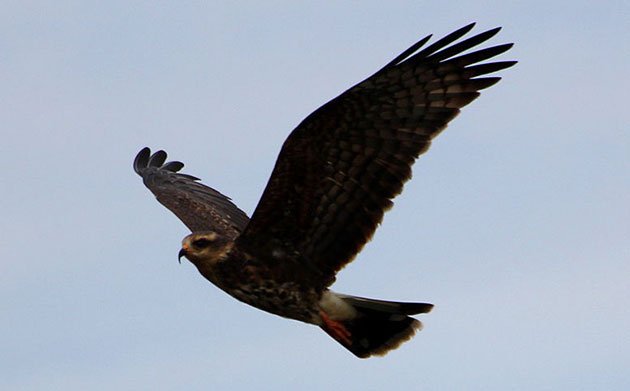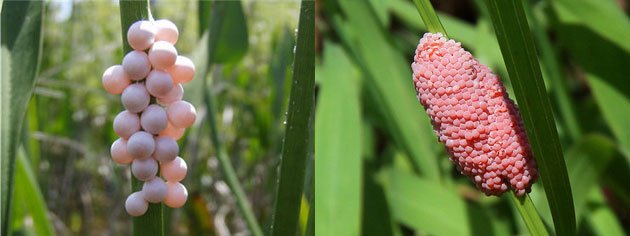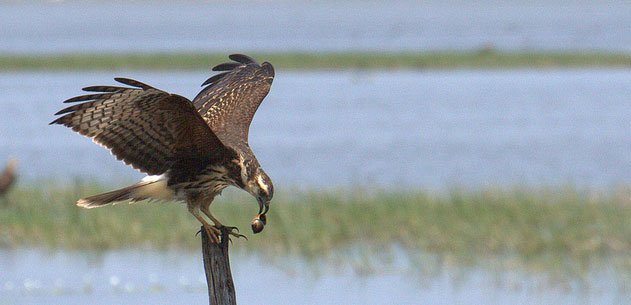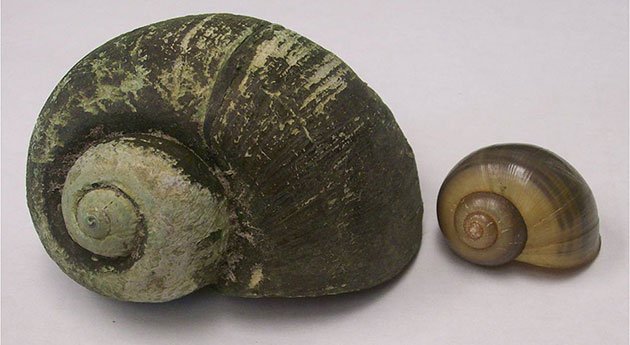
The critically endangered Everglade Snail Kite (Rostrhamus sociabilis) is making a comeback aided by an unintended introduction of an exotic snail. Over the last weekend, I was at Lake Kissimmee in Florida, observing Snail Kites at an area kites were not present or rare just a few years ago. Kites now nest there and are fairly common.
The threat of extinction of such iconic Florida bird prompted State and Federal agencies to find solutions to stop and reverse the declining trend. Snail Kites feed nearly exclusively on the golf ball-sized apple snails. Decades of land transformation and hydrological changes resulted in the decline of the only species of apple snail native to Florida and the kite population followed suit. It would take years to restore such large scale landscape changes, perhaps not soon enough to reverse the kite’s population downward trend.
While the native apple snail continued declining, another species of apple snail native to South America began to appear in canals and ponds in South Florida. The baseball-sized “Island apple snail”, as this exotic snail is known, spreaded through South Florida. Interestingly, as the exotic snail continued to expand, some biologists thought this new snail may be contributing to the decline of the snail kite population. The thought was that Snail Kites spent more time and energy handling this larger snails and don’t attain a positive nutritional balance at the end of the day. This idea made no sense to me. Kites may be spending more time handling a larger snails, but get greater nutritional value out of it. Catching and eating a larger snail meant kites do not have to fly and spend additional energy to get three of the native apple snail per unit time. Intuitively, this should result in a positive nutritional balance at the end of the day. Also, if handling large snails was a problem, then kites would only catch the exotic snails the size they feel they can handle or those the size of a native snail – kites were consistently getting the big snails. Finally, the exotic Island snail occurs in Argentina, Brazil and Bolivia where they are consumed by Snail Kites there (the Snail Kite occur throughout South America, the Everglade Snail Kite is a sub-species).
Exotic apple snail (left) and native apple snail (right) Photo: The Pomacea Project
Putting blame of on the exotic apple snail seemed a case of ecological prejudice. We are conditioned to think that any exotic species means some kind of harm to native communities. No doubt this is often true, especially in Florida where we have so many introduced species, some of which seem to out-compete their native counterpart.
The exotic apple snail is certainly out-competing the native Florida apple snail. Native snails lay 20-50 eggs at a time during the spring. Exotic snails lay 300-500 eggs at a time, lay eggs throughout the year, and are more resistant to environmental changes. Unlike the native apple snails, the exotic snails prosper in many habitat conditions including stagnant water and just about any vegetation type. These differences make the exotic snail a more successful species in Florida’s ecosystems.
 Eggs of the native apple snail (left), and the exotic apple snail (right)
Eggs of the native apple snail (left), and the exotic apple snail (right)
Exotic snails have found ideal conditions in Florida and seem to be exploding in numbers. Large number of snails can have consequences considering that the native snails eat algae that grow on plants while the exotic snails eat plants. For instance, the exotic snail have reproduced in such high numbers in some stormwater treatment ponds that they have consumed all the vegetation that once grew there. Exotic snails are so dense at these ponds that if a blindfolded person stick his hand anywhere in this pond s/he is likely to grab a snail. Snail Kites now favor these ponds and breed around them. The main source of mortality for chicks on the nest and post-fledgling kites is starvation. Adult kites are also known to abandon their chicks when they are unable to find enough food for the chicks and themselves. Lack of food is not a problem in sites where exotic snails have become abundant.
The reason exotic snails have reached such high number at the stormwater treatment ponds is perhaps due to the lack or low numbers of fish that feed on newly hatched snails. Open and interconnected bodies of water have predatory fish and other animals that feed on small snails, which should prevent such explosive growth of the exotic snail population.
 Female Everglade Snail Kite. Photo: James-Diedrick
Female Everglade Snail Kite. Photo: James-Diedrick
The Everglade Snail Kite’s story in Florida is rather perplexing. Environmentalists generally advocate the immediate elimination of exotic species for fear of detrimental effects on native species and ecosystems. The native apple snail eats algae and populations seem to be regulated by various factors. The larger exotic snail eats plants, does well in many conditions, and has the potential to explode in number, degrade habitats, and deplete resources needed by native species in ways that cannot be predicted. At the same time, the exotic snail has become the life preserver for the endangered Everglade Snail Kite; we all want to see the kite do well. I would say we need to celebrate the recovery of the kite and remain cautious about unintended consequences of letting the exotic snail reproduce and spread in Florida’s ubiquitous bodies of water.














Leave a Comment